When the alarm clock went off at 3:30 AM Sunday morning I never even heard it. Daisy did though, and awakened me, and our sleep-clogged bodies got ready for a full day’s birding in the Adirondacks without the help of our still-sleeping brains. We picked Will and Danika up and headed west on the New York State Thruway to Amsterdam where we drove north on Route 30. Shortly after sunrise and the town of Speculator we turned off onto Perkin’s Clearing Road, a dirt road that provides access to Pillsbury Mountain. Our goal was not the mountain, however, but the Mourning Warblers that breed in the brush that has grown up in recently-logged areas along the road.
We drove slowly, stopping every couple minutes to listen to the birdsong, hoping to hear the “Churry-churry-churry-cheereeoh” of a singing male Mourning Warbler. We didn’t hear one as we drove but we did hear several Northern Parulas, Black-throated Blue Warblers, Black-throated Green Warblers, Swamp and Song Sparrows, Blue-headed and Red-eyed Vireos, American Redstarts, Magnolia Warblers, a couple Canada Warblers, Wood, Hermit, and Swainson’s Thrushes and enough other species that listing them would become boring for both you and me. A highlight was a Ruffed Grouse with young that, not surprisingly, didn’t seem interested in posing for photographs.
A stop where a slow-moving stream crossed the road was rewarded with this fog-shrouded view:
Once the sun burned the fog off we were rewarded even more by a rather cooperative Northern Parula:
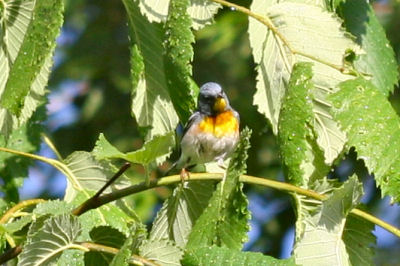
The gorgeous male sang and searched for food and sang some more, unconcerned with our presence. We watched for awhile until we remembered our goal of a Mourning Warbler and we moved on, but not before a female Wood Duck flew over:
Continuing up Perkin’s Clearing Road we passed several spots that seemed good for our quarry but couldn’t find the notoriously skulking warbler. We did add Chimney Swifts, Least Flycatchers, Black-capped Chickadees, Hairy and Pileated Woodpeckers, Yellow-bellied Sapsucker and Northern Flicker to our list. The flicker, of the eastern, yellow-shafted variety, posed for Daisy to take a shot:
We arrived at a nice boggy spot and got out of the car to explore a bit. A couple Lincoln’s Sparrows gave great looks and we could hear and eventually see Olive-sided Flycatchers on some dead snags out in the bog. Both were year birds for me, and unexpected in the unassuming boggy spot we were searching. Also present was a family of Hooded Mergansers consisting of a hen and somewhere between five and ten young. Getting an accurate count was impossible with all the vegetation they were swimming around and using for cover.
Then, from up the road a bit, came the “Churry-churry-cheereeoh” of a Mourning Warbler. I outpaced Will and managed to get a decent look at a stunning male, singing low in the brush and perching a bit higher up after each song. By the time Will caught up the bird had moved back into denser brush and did not come back into sight. Fortunately for Will, he counts heard birds!
We drove back out onto Route 30 and headed north to Blue Mountain Lake where we turned off and headed west on Route 28 until we reached Raquette Lake. There we detoured onto the dirt Uncas Road, stopping to appreciate roadside Veerys and Red Squirrels. Then we got back out of the car for the short hike into Ferd’s Bog, where we hoped for more boreal birds.
For the second time in a row Ferd’s Bog was disappointing. The only boreal species present were Boreal Chickadees and Lincoln’s Sparrows. The chickadees moved with a mixed flock of young Black-capped Chickadees, Red-breasted Nuthatches, Yellow-rumped Warblers, and a Blackburnian Warbler. The Lincoln’s Sparrow was even more cooperative than the ones along Perkin’s Clearing Road:
We also had the pleasure of watching a Sharp-shinned Hawk sally forth to drive off a Red-tailed Hawk and Will spotted a Broad-winged Hawk while the rest of us were looking at chickadees. The plant life at Ferd’s Bog was pretty impressive too:
Round-leaved Sundew (Drosera rotundifolia)
Bog Laurel (Kalmia Polifolia), or it might be Sheep Laurel
Thanks to Patrick for the plant identification help.
We walked out of Ferd’s Bog disappointed that we hadn’t managed to track down either northern woodpecker (American Three-toed and Black-backed), but ready to drive still further north in search of the elusive woodpeckers of the north woods. We had good information about nesting Black-backed Woodpeckers by Moose Pond near Bloomingdale but when we finally arrived we found no woodpeckers. We did find a couple of other birders and the presumed nesthole but it appeared that the woodpeckers had fledged and fled. The trip to the pond wasn’t a total bust though, as a fox ran down the road right past the car:
We still had one more bog to check out and despite having to leave my car parked halfway down the very rough Bigelow Road we managed to reach Bloomingdale Bog where we found…almost nothing. We did see a couple more Lincoln’s Sparrows and a pair of Rusty Blackbirds and heard a singing Nashville Warbler and Golden-crowned Kinglets but that was pretty much it except for a brief look at a Fisher running across the road.
Seeing the Mourning Warbler, Lincoln’s Sparrows and Olive-sided Flycatchers brought my year list for New York State up to 255 so I need only 45 more species to reach my goal of 300! And I will be making another trip up to the ‘daks this weekend so hopefully the woodpeckers will cooperate. Finally, if you want another take on the day check out Will’s post on The Nightjar.



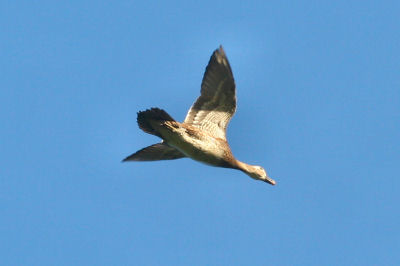
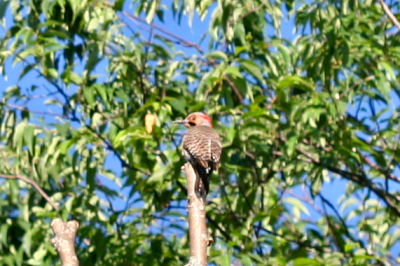
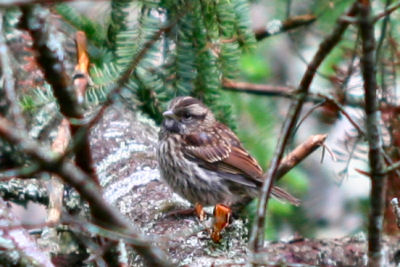
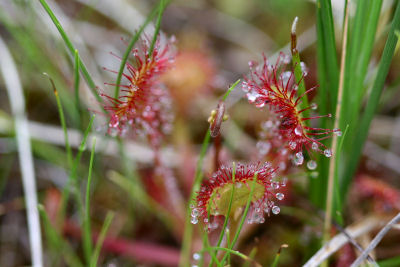
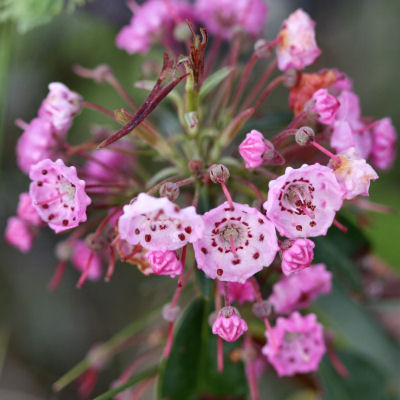
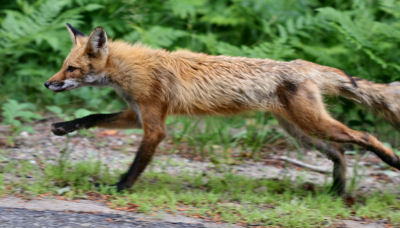











I would go with Bog Laurel. I did a little more research. Bog Laurel blooms on top of the stem and Sheep blooms in the middle of the stem. Also, Sheep Laurel is a late spring breeder (but that could depend on your latitude). I don’t think we get Bog Laurel in NJ.
How come it says there are 2 comments, but I only see one? I’ve noticed this before on the site too… Weird. Maybe it’s just me.
BTW, I tagged you with a meme. Think of it as an easy post for the day. Or just ignore it 🙂
http://hawkowl.blogspot.com/2007/07/eight-random-facts-meme.html
For the woodpeckers, you might want to try along the trails to Ampersand mountain or St. Regis mountain.
Your pictures are great. Sometimes it is worth getting up before dawn!
@Patrick: The other comment is a pingback from Will linking over to the post…and how did you like my independant studying on the laurel (I was paging through a fieldguide in a bookstore and saw the bog laurel…)
@Marne: I’m hoping to track down at least one of the two this coming weekend…